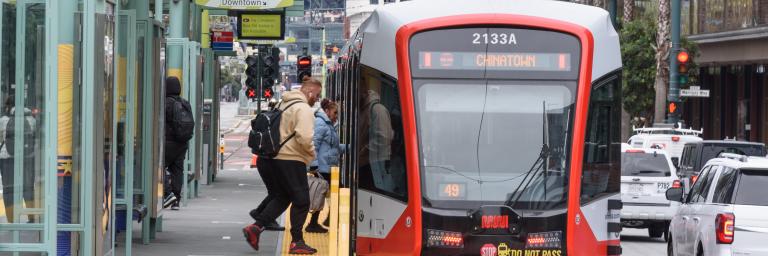The SFMTA is working to make the T Third service faster and more reliable by fixing delays along one of San Francisco's most important transit lines. Launched in 2007, the T Third connects historically underserved southeast neighborhoods, such as Bayview-Hunters Point and Visitacion Valley to places like Chinatown, Union Square, Mission Bay, SoMa, and Dogpatch. In 2022, the opening of the Central Subway expanded the T Third's reach to Chinatown. Today, about 20,000 people ride the T Third every day.
The street-level section of the T Third route often faces delays and long travel times, which makes trips slower and less reliable. These problems especially affect Bayview-Hunters Point residents, who rely on the T Third to get to work, healthcare, and school.
In 2020, the Bayview Community-Based Transportation Plan listed improving the T Third's reliability as a top community priority.
The Bayview Community-Based Transportation Plan (2020) identified improving the T Third's reliability a top priority for the community.
To help solve these problems, the T Third Improvements project will focus on ongoing, targeted upgrades. The goal is to make trips faster, reduce delays, and improve the experience for everyone who rides the T Third.
Upcoming Improvements
The SFMTA is studying the causes of delays along the T Third and is planning a range of upgrades to improve service. The first part of the project will focus on low-cost improvements that can be done quickly. Since most of the T Third operates in a dedicated transit lane, delays mostly happen at traffic signals. To address this, early improvements will prioritize signal timing changes and adjustments to transit signal priority (TSP) at the most delayed intersections. These changes are expected to start in fall 2025.
The SFMTA has used TSP for over ten years to help Muni move more smoothly. TSP works by adjusting traffic signals so buses and trains wait less at red lights. After reviewing delay data, SFMTA will focus on the intersections where trains are delayed the most. These upgrades will make trips faster and more reliable without making disruptive street changes.
- Planning
- Preliminary Engineering
Related Projects
- The Connected Corridor Project will add more traffic signal sensors along 3rd Street. This will let signals adjust in real time to help trains move faster, using advanced technology.
- The Train Control Upgrade Project (TCUP) will modernize the train control system on all Muni Metro street-level lines, improving speed and reliability.
- All of the T Third Improvements upgrades are part of the Muni Metro Modernization Program, which is working to update San Francisco's light rail system to better serve current and future riders.
Past Improvements
Timeline of T Third Improvements
- 2007 - Launch of the T Third line.
- 2018 - Most T Third trips began using 2-car trains instead of 1-car trains to reduce crowding.
- 2019 - Elimination of mid-run switchbacks and platform expansion at Chase Center streamlined service.
- 2021 - A new transit lane was introduced on the 4th Street Bridge, closing one of the few remaining gaps in dedicated transit lanes.
- 2022 - Central Subway service began, with new underground stops at Yerba Buena/Moscone, Union Square/Market Street, and Chinatown-Rose Pak stations.
These improvements have significantly enhanced service and laid the groundwork for the next round of upgrades.
